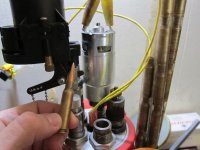Stats Shooter
New member
I have found a fairly quick way to trim brass at a relatively low cost. I know Dillon has a trimmer you attach to the Toolheads, and RCBS, hornady etc make case prep stations. But I think my way may be more attractive for some folks.
I'm using an RCBS trim pro 2, the 3 way cutter heads that trim and deburr all at once, and the power adapter made by DACaM reloading tools so I can use a cordless drill. Tonight I trimmed and deburred 1,250 .223 cases in about 2 hours....no sweat.
The setup will cost about $90 for the RCBS trimpro , a 3way cutting head and pilot is $40 or so. And power adapter is $12.50. the same 3 way cutting head can be used for several calibers, you just have to buy different pilots, but I have entirely new heads for each caliber I load because adjustment can be a bit of a pain.
I tried the little crow trimmer. It was fast, but then I still had to deburr and chamfer.
I'm sure there are some folks on here with more elaborate ways of doing this tedious task. But the method described above gave trimmed lengths of +/- 0.001 and an identical deburr and chamfer on each case...1250 in two hours.
I just thought I would share this if someone is looking to process a good bit of brass.
I'm using an RCBS trim pro 2, the 3 way cutter heads that trim and deburr all at once, and the power adapter made by DACaM reloading tools so I can use a cordless drill. Tonight I trimmed and deburred 1,250 .223 cases in about 2 hours....no sweat.
The setup will cost about $90 for the RCBS trimpro , a 3way cutting head and pilot is $40 or so. And power adapter is $12.50. the same 3 way cutting head can be used for several calibers, you just have to buy different pilots, but I have entirely new heads for each caliber I load because adjustment can be a bit of a pain.
I tried the little crow trimmer. It was fast, but then I still had to deburr and chamfer.
I'm sure there are some folks on here with more elaborate ways of doing this tedious task. But the method described above gave trimmed lengths of +/- 0.001 and an identical deburr and chamfer on each case...1250 in two hours.
I just thought I would share this if someone is looking to process a good bit of brass.

